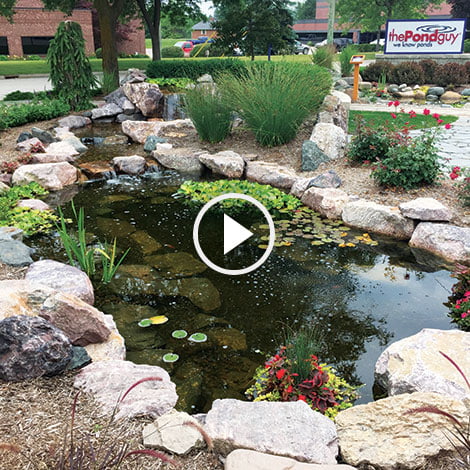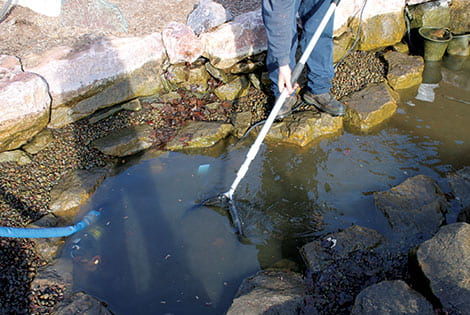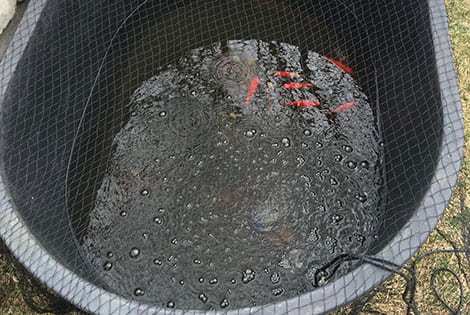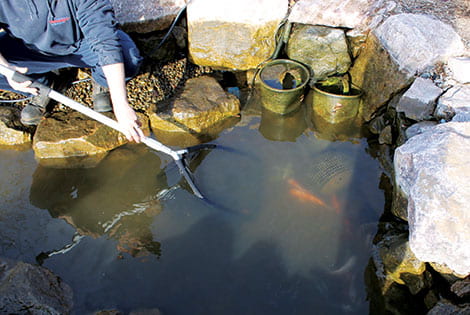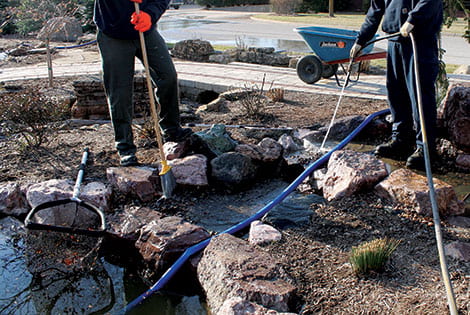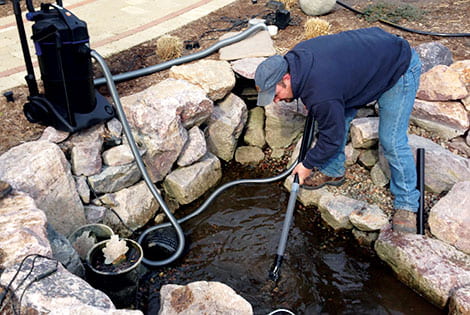Over the course of a year, your pond will accumulate debris and organics such as leaves, twigs, grass clippings and fish waste. Although your filtration system may remove some of this debris, the rest will break down into muck and sludge, which will release nutrients into the water and may cause algae and water clarity issues.
Here is a step-by-step approach on how to perform a spring clean-out. We recommend performing a spring clean-out once a year. A spring clean-out is designed to give your pond a fresh start which will translate into clearer water and happy fish.
If leaves and debris are minimal from the fall & winter, a quick vacuum and a 20% water change may be enough to get your pond ready for the spring. Be sure to check your equipment and add proper doses of beneficial bacteria.
Now let's get started:
Tools to Get Started
Here are some items to get you started:
To Keep You Dry:
- Waders
- Aqua Gloves
If you have fish:
- Holding tank or kiddie pool
- Fish Net
- Pond Netting
- Aeration Kit
For Draining & Cleaning:
- Submersible pump and drain hose
- Power Washer
- ClearVac Pond Vacuum
- Oxy-Lift Defense
- Black Waterfall Foam
For Jumpstarting Biological Filters:
Step 1 - Prepare a holding tank.
Before you begin, it is helpful to wear waders and Aqua Gloves for the entire process, or be sure to keep them handy.
Prepare a holding tank for your fish by using a clean kiddie pool, holding tank or even a Rubbermaid Tub. Your holding tank should be placed near the pond in a cool, shaded area.
Place your pump in the pond and attach the drain hose. Fill your holding tank with water from your pond. Make sure to fill just enough to keep your fish comfortable in their temporary tank.
As you pump water out of your pond, larger fish will usually stay from the pump on their own, but if you are concerned that some fish are getting too close, use a
pump sock. The next item to add to the holding tank is an aeration kit, like the PondAir2. An aeration kit will ensure the oxygen levels in the holding tank stay saturated.
Step 2 - Remove fish & drain your pond.
Continue to drain your pond until there is about one foot of water left. Catching and removing fish can be tricky; reducing the pond's water level to about one foot will make it much easier to catch your fish.
Use a
fish net to gently remove your fish from the pond and place them into the holding tank. Fish may be startled in their temporary tank and may jump. Secure pond netting over the tank to ensure your fish stay inside.
Step 3 - Power wash the pond.
After your fish have been removed, finish draining the pond. You can use this nutrient-rich water to water nearby plants or gardens.
Remove heavy and large debris, such as leaves and twigs, from the pond by hand. With the large debris cleared, you can easily access the rocks with a power washer to remove algae, muck and other build-ups. Start from the top of the pond, such as a waterfall, and work your way down, forcing the dirty water toward the pump for removal.
The
ClearVac Pond Vacuum may be helpful for emptying out the last few inches of water and small debris that the pump cannot reach.
For rocks with stubborn debris build-up, sprinkle
Oxy-Lift Defense over the area and rinse after about 10 minutes. Continue power-washing and pumping out the dirty water. Do this a few times to ensure a good cleaning.
Step 4 - Make adjustments.
While there is no water in the pond, this is the perfect time to check for any plants that look overgrown or need to be divided and repotted. For more information, see
Plant Maintenance - Season by Season.
Check low areas around the pond's edge. Fill in any area that the soil may have washed away and adjust the liner accordingly.
If you have a skimmer or waterfall filter, check to make sure they are level and did not shift during the cold weather. Remember, waterfall filters should be tilted slightly forward for even water flow.
Finally, adjust rocks in the pond or waterfall that may have shifted during the winter. Use
waterfall foam to help fill in any gaps and secure rocks back into place.
Step 5 - Check the lights.
Check existing lights to ensure they are shining in the right direction and in working condition. Be sure to clean the lenses and change out any non-working bulbs.
This is a great time to add pond lighting or add in additional lights. Check out this article for additional lighting tips:
Installing & Maintaining Lighting.
Step 6 - Reconnect the plumbing & filters.
You are now ready to reinstall your pump back into the pond or skimmer filter. Place the pump back into the pond and connect your check-valves and tubing.
If your pond was equipped with a UV clarifier, be sure to replace the bulb before reinstalling. The intensity of a UV bulb degrades over time and should be replaced every year. Don't forget the quartz sleeve; build-up should be removed to let the light through. Be sure to check out the manual for instructions on UV maintenance.
If your pond is equipped with a pressurized filter, replace the UV bulb as well as the filter media.
If you have a waterfall filter, wash or replace the filter media. Once all filter media has been washed or replaced, we recommend seeding the media with beneficial bacteria.
Microbe-Lift PL Gel or Pure+ Filter Start Gel is perfect for getting a jumpstart on bacteria growth.
Step 7 - Refill your pond.
Now it's time to refill your pond with fresh water. Depending on pond size, this may take some time. Add Stress Reducer Plus to remove any chlorine, detoxify heavy metals and aid in the re-acclimation of your fish.
Step 8 - Start-up your pond.
You are ready to plug-in your pumps and filters to circulate the new pond water. Check for any loose connections or areas where the water may be escaping.
Once the filters and plumbing have filled with water, be sure to top off the pond.
Step 9 - Reintroduce your fish.
Add some of the new pond water to your holding tank. This will allow the fish to gradually get used to their new environment. Give your fish about 20 minutes to adjust to the new water chemistry and temperature before reintroducing them to your pond.
When ready, remove the netting from the holding tank and gently move your fish back into the pond. If you used the aeration kit from your pond for the holding tank, be sure to add it back into the pond.
We recommend waiting 24 hours to allow your fish to fully adjust to the pond before you begin to feed them.
Step 10 - Clean up & add natural bacteria.
Give your pond a boost by adding your first dose of
Seasonal Defense. This cold water beneficial bacteria helps replenish winter bacteria loss, to further boost biological filters and break down waste. Follow up with routine maintenance to ensure a successful pond season.
Congratulations, you have successfully completed your pond clean-out!
Last Updated: June 10, 2024
